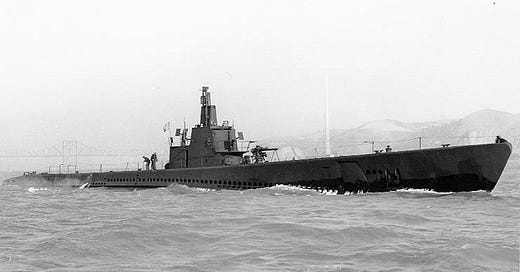TDIH: USS Squalus Sinks
Would the crew of the USS Squalus become the first to survive such a tragedy?
On this day in 1939, a Sargo-class submarine sinks during a deep dive. No submarine crew had ever been rescued once they'd sunk below 20 feet. Would the crew of the USS Squalus become the first to survive such a tragedy?
Submarines had a bit of a bad reputation during the early 1900s. As many as 825 men died aboard submarines between 1921 and 1938. Rescues in deep water were difficult. In fact, service aboard a submarine was sometimes dubbed “the coffin service” because of the low rate of survival during these incidents.
How much courage and patriotism it must have taken to serve aboard a submarine in those years!
Real efforts were made to improve the technology of submarines, and Squalus was considered to be on the cutting edge of this technology. The submarine was as big as a football field, and it could dive down to 250 feet. It could travel 11,000 miles without refueling. By 1939, it was undergoing sea trials in Portsmouth, New Hampshire. The first 18 tests were successful, but the 19th trial ended in disaster. The tragedy occurred when Squalus was testing its ability to submerge at a high speed.
Lt. Oliver Naquin was leading the effort that day. The submarine’s initial descent seemed to be going well, but, suddenly, frantic voices could be heard from the engine room: “Take her up! Take her up!” The main air induction valve was open. Had it been left open or did it come open? To this day, no one knows. Either way, water was quickly filling the rear compartments of the submarine. Twenty-six men were in those compartments. It was later discovered that they drowned early in the disaster.
Naquin tried to reverse course and resurface Squalus, but the submarine tilted hard at a 45 degree angle and began sinking to the ocean floor. The Chief Electrician’s Mate, Lawrence Gainor, fortunately followed his instinct to check the battery compartment. The batteries were shorting and sparking, and Gainor feared an explosion. He climbed into the battery compartment and turned off all power to the ship. He knew that he could have been electrocuted at any minute, but he did it anyway.
At one point, an Electrician’s Mate, Lloyd Maness, was ordered to shut a watertight door. Imagine water washing through tight spaces. Men yelling at their friends to hurry up and get through the door. Maness realizing, too late, that his good friend was on the wrong side of a sealed door. That friend was supposed to get married the next weekend. Maness was the Best Man.
All of these things happened.
When all was said and done, the submarine had sunk about 240 feet. Four of the seven compartments were flooded. No submarine crew had ever been rescued from such a position. The trapped crew would have been well aware of that fact. How must they have felt?
Naquin estimated that he had 48 hours before he ran out of oxygen. He sent a telephone buoy to the surface with a message: “Submarine sunk here. Telephone inside.” He and the crew set off red smoke rockets, and they even managed to shoot oil to the surface using the submarine’s toilet ejection mechanism. He gathered his men together, along with some Momsen lungs, a new breathing device meant to aid in rescues. Then, there was nothing to do but wait.
Naquin later wrote: “Never in my remaining life do I expect to again witness so true an exemplification of comradeship and brotherly love. . . They shared their blankets, the crowded deck space, lay in each other’s arms in an effort to keep one another a little warmer.”
Would the crew be found in time to rescue everyone safely? Naturally, the story continues tomorrow morning.
Sources can always be found on my website, here.





My grandmother’s brother was a sailor trapped and drowned in the flooded compartments. He’s buried at Arlington.
Ahhh you leave us hanging with bated breath, but nothing that compares to those poor seamen awaiting an unknown destiny.
As usual I look forward to “the rest of the story” (Paul Harvey).
❤️🇺🇸🇺🇸🇺🇸